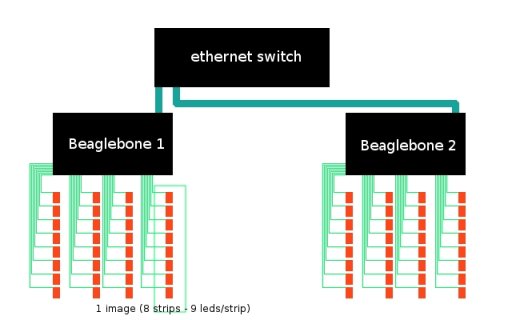Hi !
I want to make a pov project, and need your help to determinate what kind of board I should use.
I bought some ws2812*(http://www.adafruit.com/products/1507)*from adafruit.* I already know that's not the greatest choice because of the*refresh rate, but for my project I just need from 72 to 96 leds (and I need their high density of pixels.)
My idea to solve this problem was to divide each strips into smaller one. That's why I first think to use some teensy board: if each neopixel could be divided into eight part, one teensy will drive 72 to 96 leds, (so 8x9 leds to 8x12 for a refresh rate from 320us to 410us for each teensy module.)
=> 8 ledstrips which contained 9 leds | the refresh rate for 1 led is 30us + 50us at the end of each strips.
So 9*30 + 50 = 320us
In order to see an entire image, it must be printed in the pov range, it means =< 40ms
So 97 to 125 ( = 40/0.320 ) frames. (which would be fine for my project).
I saw a project named Ledscape (I see two thread on this forum, and made some research on it)
If I understand what it does, it should be cheaper for me to use a beaglebone to drive several module of 8x9 or 8x12 leds.
(but I really don't know how to use it, or which files I have to study and modify)
I need a communication between the boards (the ethernet, and sd card from the beaglebone should be nice for that).
Because of the specific refresh rate from the neopixel strips, the project passed from arduino/artnet to teensy/artnet or usb to beaglebone+ethernet
Here is my question :
Am I understanding the ledscape project the good way ? Could it fit my project ?
Thanks in advance.

I want to make a pov project, and need your help to determinate what kind of board I should use.
I bought some ws2812*(http://www.adafruit.com/products/1507)*from adafruit.* I already know that's not the greatest choice because of the*refresh rate, but for my project I just need from 72 to 96 leds (and I need their high density of pixels.)
My idea to solve this problem was to divide each strips into smaller one. That's why I first think to use some teensy board: if each neopixel could be divided into eight part, one teensy will drive 72 to 96 leds, (so 8x9 leds to 8x12 for a refresh rate from 320us to 410us for each teensy module.)
=> 8 ledstrips which contained 9 leds | the refresh rate for 1 led is 30us + 50us at the end of each strips.
So 9*30 + 50 = 320us
In order to see an entire image, it must be printed in the pov range, it means =< 40ms
So 97 to 125 ( = 40/0.320 ) frames. (which would be fine for my project).
I saw a project named Ledscape (I see two thread on this forum, and made some research on it)
If I understand what it does, it should be cheaper for me to use a beaglebone to drive several module of 8x9 or 8x12 leds.
(but I really don't know how to use it, or which files I have to study and modify)
I need a communication between the boards (the ethernet, and sd card from the beaglebone should be nice for that).
Because of the specific refresh rate from the neopixel strips, the project passed from arduino/artnet to teensy/artnet or usb to beaglebone+ethernet
Here is my question :
Am I understanding the ledscape project the good way ? Could it fit my project ?
Thanks in advance.



